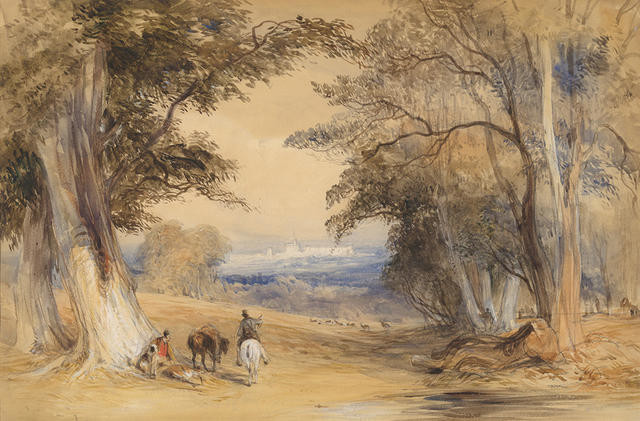William Payne
British, b.1760, d.1830
Windsor Castle from the Great Park
- c. 1820s
- Watercolour
- Heathcote Helmore bequest, 1965
- 590 x 740mm
- 69/321
- View on google maps
Tags: animals, horses (animals), landscapes (representations), monochrome, natural landscapes, people (agents), trees
Windsor Great Park in England was set aside in the eleventh century as a personal hunting ground by William the Conqueror, supplying Windsor Castle with deer, boar and fish as well as wood. The park endured as a domain of royal privilege; by the early nineteenth century, hunting there was still restricted to royalty, aristocrats and individuals with connections to the monarchy.
(Out of Time, 23 September 2023 – 28 April 2024)
Exhibition History
William Payne was an innovative watercolourist. He developed a unique style of painting using a brush, instead of pen or pencil, to make outlines – known as ‘dragging’, this technique accurately captured the texture of gravel or stone. Payne also developed a grey pigment known as ‘Payne’s grey’, which is still used by watercolourists today. Windsor Castle is one of the principal official residences of the British Monarch and has been continuously occupied for over 900 years. The castle can be seen in the distance surrounded by forest, while in the foreground hunters gather around a deer they have just shot. Payne was born in Plymouth in 1760 and was initially employed as an engineer at the naval dockyards in Plymouth. He began to paint parttime, and by 1786 he was exhibiting with the Royal Academy. In 1790 he moved to London to pursue a career as a professional artist and established a highly successful practice as a drawing master.
(Label date unknown)
![Andreas Cellarius Hypothesis Ptolemaica Sive Communis Planetarum Motus Per Eccentricos Et Epicyclos Demonstrans [The Ptolemaic Hypothesis or Common Representation Demonstrating the Planetary Motions through Eccentrics and Epicycles] 1661. Hand-coloured engraving. Collection of Christchurch Art Gallery Te Puna o Waiwhetū, William A. Sutton bequest, 2000](/media/cache/05/97/05970cdff0f6b3264062d69bf2aa90f5.jpg)
